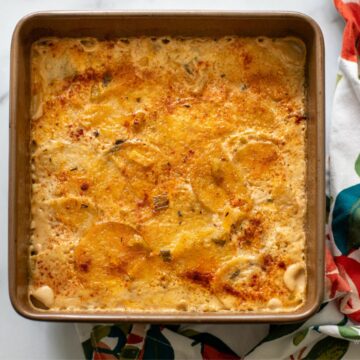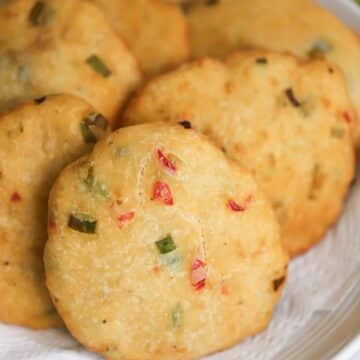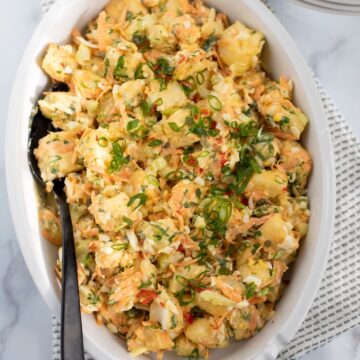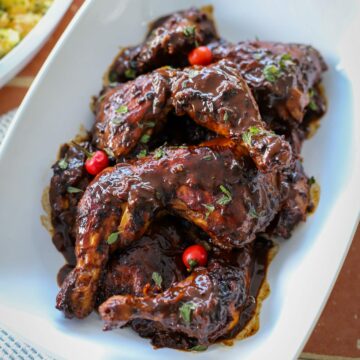
When a woman gives birth there is a connection between her and the women who came before her- they understand her pain and the type of nourishment her body needs for healing. Some cultures feed their new moms specific foods to promote health and lactation. I cherish these type of foods- ones that are made for women, by women. And although that can be said for many dishes, this one in particular is unique because it has a special purpose.
In Indo-Caribbean culture, Halwa is made after the birth of a baby and is served to the mother to help "clean out her insides" as well as aide in breast milk production. This sweet pudding starts with a robust blend of carefully selected spices (known as masala) which are ground then parched. A sweetened flour-milk mixture is added then simmered until the mixture thickens, resulting in a delicious spiced pudding. It's not the prettiest to look at and might be an acquired taste for some. This type of halwa is commonly served with dosti roti or plain paratha roti and enjoyed by both men and women alike on the 9th day after a baby is born. Although my grandmother made it for me to consume as soon as I was able to eat after having both of my kids.
How does the Indo-Caribbean version differ from other recipes?
The term halwa, is used broadly to describe different types of semi-solid reductions based from either flour, nuts, or grains. Some varieties are smooth and soupy or firm and dense, like Turkish delight. Carrot halwa seems to be the most popular type of halwa in Indian and Middle Eastern cultures, however, growing up in an Indo-Caribbean family, when my grandmother referred to halwa she was talking specifically about the halwa I am sharing with you today. She didn't only make this for new baby celebrations, it was something she made whenever all of her daughters were together or just as a simple breakfast.
Indo-Caribbeans also make another type of halwa known as lapsi (although we never call it halwa)- a basic white pudding made essentially from flour, milk, sugar, and ghee. You will typically find lapsi at Hindu prayer ceremonies or jhandis. Check out this recipe for lapsi and puri from Matthew's Guyanese Cooking on Youtube. He does a wonderful job explaining his techniques and his food looks delicious!

About the Texture, Color, and Taste
The variety of halwa textures vary based on person. My grandmother's version is smooth and loose, while others make this a little more thick like a rice pudding texture. The pudding needs to be smooth and not lumpy. The lumps can be a turn off which is why the mixture is passed through a sieve when cooking. The color will vary based on the type of halwa masala used. Some are lighter in color, while others dark as chocolate. My grandmother adds turmeric to the pre-packaged masala to lighten up the color. Lastly, the taste is sweet and mildly spiced. This recipe has a little condensed milk which helps with a balanced sweetness.

My Grandmother's Version
Halwa was not the first food on my mind after giving birth. To be honest, I really just wanted pizza (shrugs shoulders). However, after seeing the careful steps my grandmother took in preparing this dish for me, I realized the spiritual essence of these type of foods serve to construct and sustain our community and authority as women. The preservation of indigenous culinary practices relies on the ability to make traditional foods such as halwa and as an Indo-Caribbean woman, I feel incredibly proud to share this special recipe with you all.
My grandmother's halwa was always smooth in texture and balanced in flavor. The spices were not overly strong and it had the right amount of sweetness. The condensed milk certainly helped with the creaminess. She also adds more ingredients to the masala mixture. She says it has to have a "zing," so she jazzes it up to her liking by adding fresh ginger, black pepper, and turmeric. I don't recognize some of the other spices in the masala mixture and she only knows them by appearance. The spices we don't recognize are peepar, mora, and havclay. If anyone knows another name for these spices or what they look like in whole form, please comment down below!











Halwa Recipe – Celebrating the Birth of a Baby
Ingredients
- 6 heaping tablespoon halwa masala (I used Maywah brand)
- 2 tablespoon freshly grated ginger (blended with 2 tablespoon water)
- 1 teaspoon turmeric
- ½ teaspoon black pepper
- ½ cup water (to make loose halwa paste)
- 1 ¼ cup all purpose flour
- 1 tablespoon ghee for frying masala
- ¼ cup Condensed milk
Milk Mixture
- 1 12oz tin evaporated milk
- ¾ cup brown sugar
- 3 cups water
Additional Equipment
- Sieve
Instructions
- Gather ingredients for masala mixture. Blend ginger with 2 tablespoon water to make it smooth. Add to bowl with masala, turmeric, black pepper and ½ cup water. Set aside.
- Make milk mixture. Combine evaporated milk, brown sugar, and water. Set aside.
- Place flour by itself in a frying pan, on low-medium heat, let flour parch (toast) a few minutes until golden brown. Place parched flour into a deep mixing bowl.
- Pour milk mixture over parched flour, stir to mix. Lumps will form which is okay at this point. Set this mixture aside.
- In a deep or heavy bottomed pot, on medium heat, add ghee. When melted, add masala mixture. Fry masala 3-4 minutes.
- This next step comes together fast, so work quickly. In one hand hold sieve over pot with masala, using the other hand, pour milk mixture through sieve into the pot with masala. Sieve will remove the lumps. Use a spoon to press out any remaining lumps.
- Quickly give the halwa mixture a turn. Add condensed milk. Mixture will get thick within a few minutes on the stove. Remove from heat once halwa is no longer watery. If you desire a thicker, more solidified consistency, let mixture dry a few minutes longer.
- Taste mixture, if needed, add a few more tablespoon condensed milk to sweeten.







Sharon says
Good Evening Alicia,
I love your post and your recipes. As a Guyanese whose mother never made anything from a recipe nor wrote anything down, you are a Godsend. Anyway, I love this recipe. I recently had major surgery and was looking for something to clean my inside out, I bought bitters, but as the name goes, it is extremely bitter. Would this recipe work to just clean me out?
Alica says
Hi Sharon,
So glad you found my site! Hope you enjoy the recipes. As for your question, my grandmother always said this was a good dish for cleansing. I am not a medical professional so I wouldn't truly know, but if you do make it, I hope it helps!
Sharon says
Good Morning Alica,
Thank you so much for responding to me. I will truly try this one. The older I get the more I look towards what my mom knew with regards to home remedies. I find that there are a lot of sound knowledge to what our parents and grandparents did. I will let you know how it turns out.
Shanta says
I love halva or I should say my mom halva 🙂 I notice she didnt use the condensed milk so maybe that's optional. Thanks for posting, now I can go try it by myself since she always eyeball the ingredients, its a guyanese thing!
Seeta says
Alica, my mom made the best Halwa. She would have been 95 yesterday. Sadly, I never watched her make it. I was craving halwa and decided to try your recipe and I must say that the end result was exactly like my mom’s. I did not use the condense milk. Your recipe was very helpful and I give you an Excellent rating on it. Thanks again.!
Devika says
Hi Alicia,
I just made this a few minutes ago and never thought I‘d ever be able to make this on my own so thank you for taking the time for sharing the recipe.
I ran into a little issue with my masala mixture, it actually was not a watery paste, it was when I first added all the ingredients together but then seems like the liquid was absorded. when I added the milk/flour mixture I had to whisk it all together. It still turned out great, just wondering if I should add more than 1/2 of water?
Thank You,
Devika